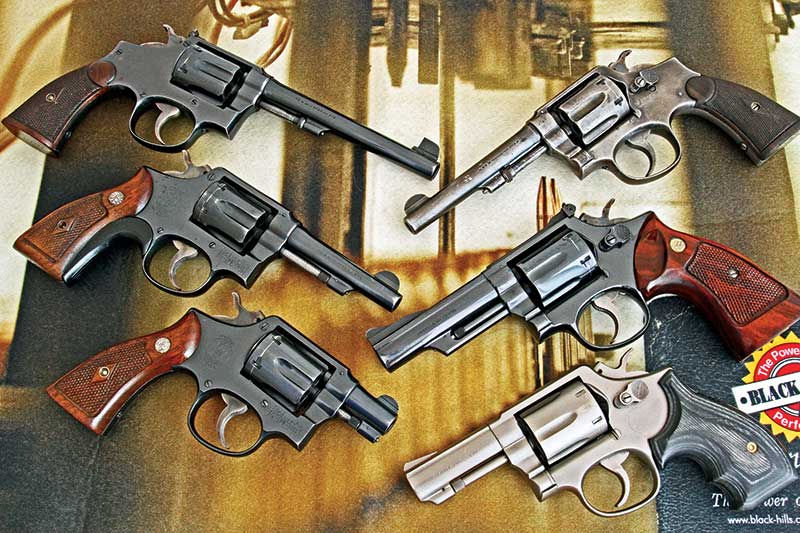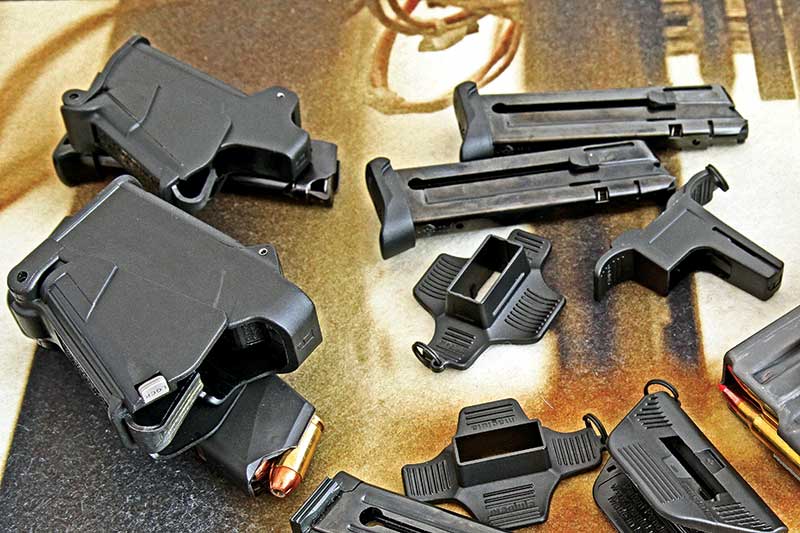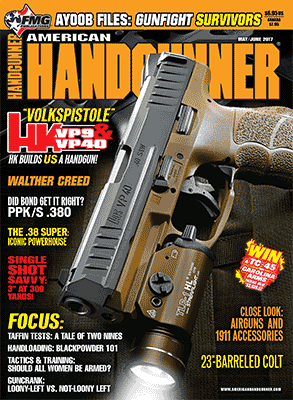Manipulation Management
With age comes decreased mobility and strength, which in turn means fewer options in terms of avoiding or resisting criminal aggression. Sometimes, just at an age when we are more dependent on firearms for defense, those firearms become more difficult to handle. I’m not speaking so much of the ability to shoot accurately or to handle recoil, but of routine gun handling.A common complaint is reduced arm strength, painful hands and fingers and reduced dexterity. Simple things such as loading cartridges into magazines, or loading/unloading semi autos, become more difficult. While there may not be perfect solutions there are ways to work around such issues.

For those with painful hands who find semi-autos hard to manage, consider revolvers such
as these from S&W. Left column from the top: M&P .38 Spl Target; M&P .38 Spl.;
M&P 2" model from early 1950’s. Right column from top: M&P .32 S&W, 5" barrel;
Model 19 .357 Mag.; model 13 3" .357 Mag with Robar NP3+ finish.
Consider A Revolver
Sometimes my wife and I go out shooting handguns just for fun. I was puzzled at first why she preferred revolvers. I let her try a variety of handguns, pointing out how the crisp, short trigger release of a semi auto was easier to learn than the DA pull of a revolver. And in fact she could shoot faster and more accurately with a 1911, GLOCK 19 or Browning Hi-Power.
What she liked, though, was the ease of handling revolvers. No broken fingernails from trying to load cartridges into magazines, no struggling with slides to load or unload. Simply press the cylinder release and swing out the cylinder, drop in cartridges, close cylinder, shoot.
If painful arthritic fingers are the issue though, a heavy DA pull on a revolver is not going to help. The DA pull in my experience takes more effort to learn, albeit mostly through dry fire, which costs only time. Cartridge capacity is limited, usually five or six rounds. Rapid reloading requires a fair amount of practice and manual dexterity.
If you can’t or won’t manage a semi auto, a revolver is a good option. Guys (like me!) have pushed up the prices on police trade-ins of S&W M&P’s but they are still a good buy. And if rapid reloading is a concern, what the heck, get two of them.
If loading cartridges into magazines has become a chore instead of fun, the clever people at Maglula have devised ways to make rifle and pistol magazine loading easier. The magnificent UpLULA handles a broad array of centerfire pistol magazines for 9mm through .45 ACP (both single and double stack), as well as some .380’s. For single stack magazines accepting .22 LR, .25, .32 or .380 ACP cartridges the Baby UpLULA does the job. I highly recommend the UpLULA’s — they work reliably, are durable and aren’t expensive.
Improve The Operator
With cartridges loaded in the magazine, the next hurdle is operating the slide to chamber that first round. There are a couple of things you can do to make the task easier: learn proper technique and increase hand and arm strength. Try increasing strength with a simple tennis or rubber ball to squeeze while watching TV.
Let’s talk about technique. Say the magazine is inserted and locked, and the pistol is held in the shooting hand, trigger finger outside of the guard and extended along the frame. The other hand grasps the slide, either pinched between thumb and forefinger (sometimes called the “slingshot” method), or with the “overhand” grip with fingers on one side and the base of the thumb on the other. Establish the grip with both hands, then give a brisk, hard push/pull with both hands. It’s like pulling off an adhesive bandage, better to rip it off with one brisk pull than to gingerly tug at it.
Remember you’re working against two springs, the recoil spring which powers the slide, and the mainspring powering the hammer. If your pistol has an external hammer, try thumb cocking it first so the mainspring is compressed, with only the recoil spring to overcome while working the slide.
If possible choose a full-size semi-auto pistol rather than a compact or subcompact. Smaller pistols have lighter slides, which develop less momentum to feed fresh cartridges. To compensate for the lighter slide they use stronger recoil springs.
Installing a lighter recoil spring and/or mainspring is a possibility, though one I hesitate to recommend. Changing springs can affect reliability; unless you know exactly what you’re doing, a good rule of thumb is to go with what the manufacturer installed.
An inexpensive way to get a surer grip on the slide is to apply a strip of skateboard tape. Some competitive shooters install “slide rackers,” handles extending from the slide. A slide racker won’t work too well for concealed carry but on a pistol kept for personal defense in the home, business, or vehicle it may be a reasonable alternative.






